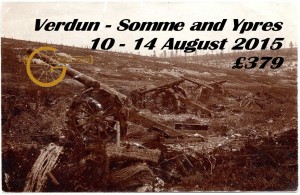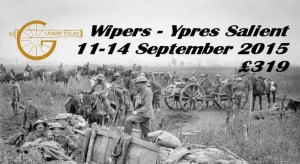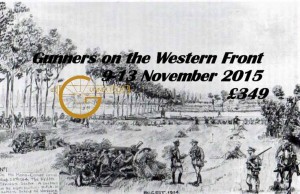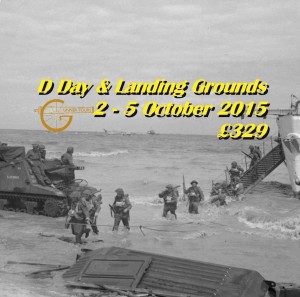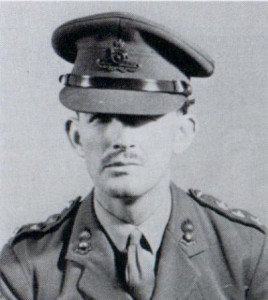
One of the first Allied soldiers to land, and be killed on Omaha beach was a Royal Artillery Officer, spy and pirate, whose story is closely linked to the James Biond story.
Omaha Beach is one of the most visited battlefields in Europe if not the world. Tens of thousands of people visit the coast between Vierville and St Laurent usually in conjunction with a visit to the Normandy American Cemetery at Colleville-sur-Mer. Some may notice the plaque on the sea wall on Dog Red beach west of the demarcation memorial at les Molins. This commemorates Operation Aquatint a commando raid which landed on the beach on 12-13 September 1942.
This raid was led by a remarkable Gunner officer who deserves to be much better known, especially by the Gunners themselves. Henry Gustavus March-Phillips(1) was a Royal Artillery Officer Reservist who served in the BEF in the 1940 battles for France and Belgium, with sufficient distinction to be awarded the MBE. Frustrated by the experience, disliking the restrictions of conventional military life and determined to make a personal contribution to winning the war, he joined the Special Operations Executive (SOE) and founded what seems to have been his own force of commandos, the Small Scale Raiding Force, also known as No 62 Commando.
This was an organisation which owed little to the usual principles behind British army organisations. About half of the 55 man unit were British Officers, with the other ranks mainly volunteers from occupied countries, and a handful of British NCOs.
According to Marcus Binney, whose father served in SOE and whose mother knew him before the War, “March-Phillips had the guts and the daring-do to carry off great coups, as well as an engaging ability to admit his own fears to others. But while courage was his greatest attribute it was also to be his undoing, for at times it veered into foolhardiness. On occasion, impetuosity clouded his judgements and prevented him from weighing risks as a commander should. His success was due above all to his ability to motivate his men, and to forge a team in which rank played little part. All worked together with total commitment, pitching their physical strength, stamina, quick wits and resourcefulness into a series of pioneer commando raids intended to show in the desperate days after Dunkirk, that Britain was still on the attack.…’ In operations that depended on careful preparation and rehearsal, intense fitness, superb morale and swift execution , March-Phillips was a brilliant leader, able to delegate tasks to others and giving all the sense of playing a vital role. Some found him exasperating, and could never have served with him, but those who did gave him their complete loyalty and trust.

March-Phillips was an archetypal English Hero, a good looking all rounder, keen on sport, a countryman but literary minded and above all , incredibly brave. He was also described by one of his NCOs as “impatient with anybody who was slow or dithery, and valued the importance of getting on with something quickly, doing whatever you did well, and a kind of built -in dislike of any sort of slackness … And a great scorn of anyone who was carrying an ounce too much weight’.
In January 1942 he met, and then married the actress Marjorie Stewart, who was working in SOE as the lift operator in Baker Street, but rose to serve in a “Miss Moneypenny” role as secretary to Patrick Howarth an SOE Controller. More about her career More about her acting career on the IMDB Database
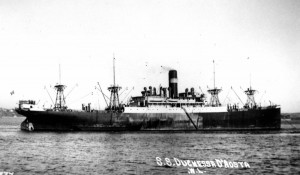
In early 1942 the SSRF carried out Operation Postmaster,, a raid to sink and seize German and Italian ships in the Neutral Spanish port of Fernando Po. The operation was a great success and March-Phillips and his men towed the Italian liner Duchess d’Aosta to Lagos in an exploit that could have appeared in a James Bond story. It has been argued that the story WAS the inspiration for some of the Bond stories, as Ian Fleming was the Press officer for the operation. Afterwards March-Phillips was awarded the DSO for the operation which also resulted in prize money from the Duchess d’Aosta. More about Operation Postmaster here.
During the Summer of 1942 the SSRF started raiding the French coast using a modified MTB, named “The Little Pisser” on account of its turn of speed. Operation Barricade was a raid to the radar site at Pointe de Saire south of Barfleur, which inflicted nine casualties on a German patrol. Operation Dryad was the abduction of the seven man garrison of the Casquets Light house on the night 1-2 September.
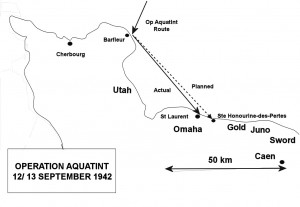
Operation Aquatint was intended to seize a German guard from the small garrison Sainte-Honorine-des-Pertes, an isolated coastal town on the cliffs between what would be known as Omaha beach and Port-en-Bessin. The raid was scheduled for the night of 11-12th September. But as one of the survivors recalled ‘We couldn’t find this ruddy kink in the cliff, so we went back the next night and still couldn’t find it. Then Gus said “What do you think chaps, shall we have a bash?”’ Sadly they had made a navigation error and were 6 km West of where they had planned. They had navigated to Cap Barfleur on the Eastern extremity of the Cotentin peninsular and plotted a course from there, but were 3.5 degrees off course. Instead of landing near the Sainte-Honorine-des-Pertes, they had landed near the village of St Laurent, in what had already been identified as a likely invasion beach. Instead of stalking a guard, they were discovered by a patrol with a dog. They attempted to seize one of the patrol, but the numerous defenders from Infantry Regiment 726 garrison, under the command of Sergeant Major Pieh (2) opened fire. No one got back to the MTB. March-Phillips and two others were killed on the night of the raid. The remainder were captured evading through France. Of these one was executed by the Germans and two others, disappeared without trace in German camps. More on Operation Aquatint here
March-Phillips, reported missing, was recommended for a bar to the DSO for his leadership, approved by Lord Mountbatten. After his death had been confirmed he was awarded a mention in dispatches, in place of the DSO which was not awarded posthumously.
Operation Aquatint was a heavy blow for SSRF and in 1943 it was disbanded and the survivors became the nucleus of the 2nd Regiment SAS. One of the SSRF members, Anders Larsen would be the recipient of the sole VC awarded to the SAS during the War.
March-Phillips was also an author and a poet. His novels include an intriguing spy novel “Ace High” featuring John Sprake as its hero. It is possible that , had he survived, Gus March-Phillips might have beaten Ian Fleming to publishing spy novels based on SOE. Perhaps the name John Sprake would be as well known as James Bond. More here about James Bond and John Sprake
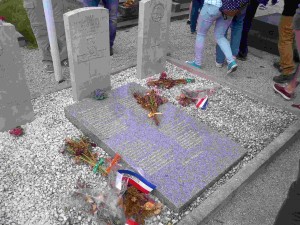
Major Henry Gustavus March-Phillips DSO MBE, Mentioned in Dispatches was buried in the churchyard of the village of St Laurent-sur-Mer alongside Sergeant Williams of the Queens Regiment and Private Leonard of the Pioneer Corps, whose real name was Richard Lehniger, a Jewish communist, WW1 veteran from the Sudetenland.
March Phillips’ grave is covered with a stone slab inscribed with what seems to be a poem of his own composition. “If I must die” which you mcan see in the photograph.
Gus March-Phillips deserves to be remembered by the Royal Artillery. Much of the contribution of the Royal artillery in the Second World War is a story of collective success as an integral part of the British war machine, epitomised by the motto “Ubique”. He was a hero, an inspirational leader and a larger than life character. Not without flaws, but a man whose actions could easily be case studies in leadership. His legacy includes the antecedents of the modern SAS. His style lives on in the world Ian Fleming created.
Gunner Tours is the only battlefield tour business to include the story of Gus March Phillips, and we tell his story and that of other Gunners in our tours to the battlefields of Normandy. Operation Aquatint wasn’t the most important historic event to take place on Omaha beach, but its story should be known to Gunners.
Join one of the Gunner Tours to Normandy this year.
Notes:-
1. The name is spelled as March-Phillipps on the Commonwealth War Graves Cemetery records, but March-Phillips in the London Gazette.
2. The name is written as Pye in some accounts. He may have been the same soldier who died commanding the defences of WN62 on D Day.
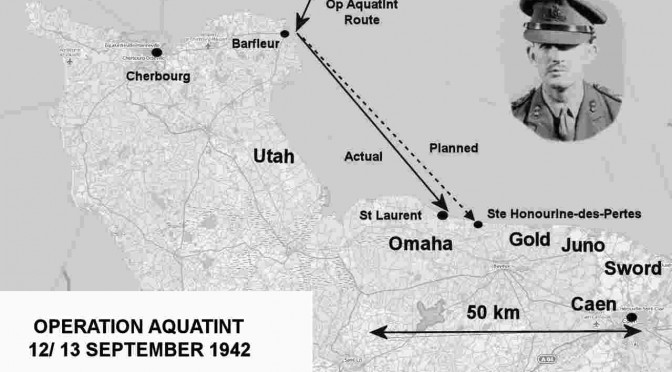


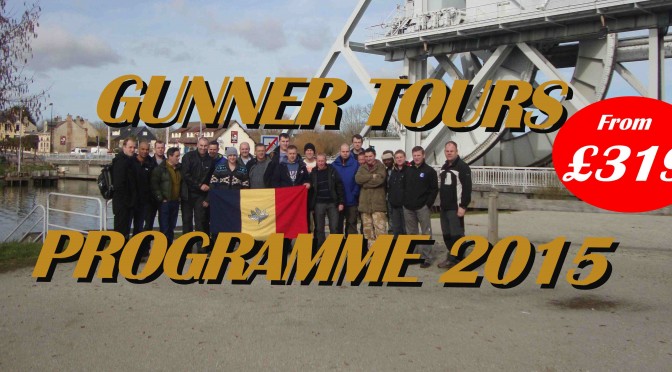
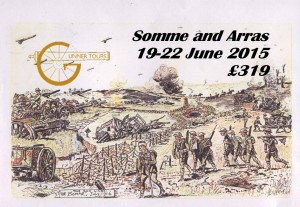 ng weekend of four days
ng weekend of four days